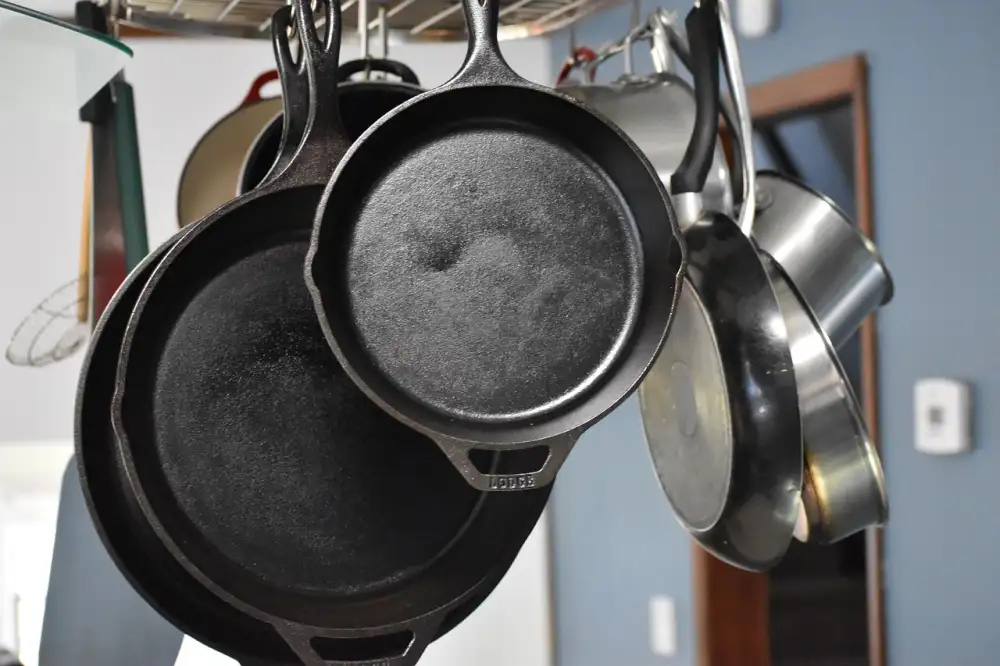Revive Your Cast Iron Skillet: A Step-by-Step Guide on How to Clean Rusty Cookware

A cast iron skillet is a timeless kitchen tool that can be passed down through generations. Its ability to retain and distribute heat evenly makes it a favorite among chefs and home cooks alike. However, if neglected, these beloved cookware items can develop rust over time. But fear not! With a little TLC, you can easily revive your rusty cast iron skillet and have it looking as good as new. In this step-by-step guide, we will walk you through the process of cleaning your rusty cookware so that you can continue to enjoy its culinary benefits for years to come. So let's get started!
Gather necessary supplies
To revive your rusty cast iron skillet, you will need a few essential supplies. First, grab a pair of rubber gloves to protect your hands during the cleaning process. Next, gather some steel wool or a scrub brush specifically designed for cast iron cookware. These tools will help remove the rust and grime from the skillet's surface. Additionally, you will need white vinegar, which is an excellent natural cleaner for removing rust. Lastly, make sure to have some paper towels or a clean cloth on hand for drying the skillet after cleaning. With these supplies ready, you can begin restoring your beloved cast iron skillet to its former glory.
Scrub the skillet with steel wool
Scrubbing the skillet with steel wool is an essential step in reviving your cast iron cookware. Start by rinsing off any loose debris or food particles from the skillet. Then, take a piece of steel wool and gently scrub the surface of the skillet in circular motions. This will help remove any rust or stubborn residue that has built up over time. Be sure to cover all areas of the skillet, including the handle and sides. Remember to apply moderate pressure while scrubbing to avoid damaging the seasoning on the skillet. Once you've thoroughly scrubbed the entire surface, rinse off any remaining residue and move on to the next step in restoring your cast iron skillet.
Create a vinegar soak
To create a vinegar soak for your rusty cast iron skillet, you will need white vinegar and water. Mix equal parts of vinegar and water in a large container or sink. The acidity of the vinegar helps to break down the rust and remove any stubborn stains on the skillet's surface. Make sure there is enough solution to fully submerge the skillet. This soak will help loosen the rust, making it easier to scrub off later.
Soak the skillet in vinegar
To begin the process of reviving your cast iron skillet, it is important to soak it in vinegar. Vinegar is a natural acid that helps to break down rust and remove any stubborn residue. Fill a sink or basin with equal parts water and white vinegar, ensuring that there is enough liquid to fully submerge the skillet. Gently place the skillet into the vinegar solution, making sure it is completely covered. Allow the skillet to soak for at least one hour, or overnight for more severe rust buildup. The vinegar will work its magic, loosening the rust and making it easier to scrub away in the next step.
Scrub the skillet again
Once the skillet has soaked in vinegar for a while, it's time to give it another good scrub. This step is crucial for removing any remaining rust or residue. Take your steel wool and gently scrub the entire surface of the skillet, paying extra attention to any stubborn spots. Use circular motions and apply a bit of pressure, but be careful not to scratch the skillet. Continue scrubbing until the skillet feels smooth and clean to the touch. Don't rush this step; thorough scrubbing will ensure that all traces of rust are gone.
Rinse and dry the skillet
Once you have finished scrubbing the skillet with steel wool and soaking it in vinegar, it's time to rinse and dry the skillet. Rinse the skillet thoroughly under warm running water to remove any remaining residue or vinegar. Make sure to get into all the nooks and crannies of the skillet. Once rinsed, use a clean towel or paper towels to dry the skillet completely. Ensure that there is no moisture left on the surface as this can lead to rust formation. Take your time and make sure every part of the skillet is dry before moving on to the next step.
Apply a thin layer of oil
After thoroughly cleaning and drying your cast iron skillet, it is crucial to apply a thin layer of oil to prevent rust from forming again. This step helps to maintain the skillet's seasoning and keep it in optimal condition for future use.
To apply the oil, you can use a paper towel or a clean cloth. Start by pouring a small amount of vegetable oil or flaxseed oil onto the paper towel. Make sure not to use too much oil as it can become sticky and create a residue on the skillet.
Next, rub the oiled paper towel all over the surface of the skillet, including the inside, outside, and handle. Be sure to cover every inch of the skillet with a thin layer of oil. This will help protect it from moisture and oxidation.
Once you have applied the oil, you can either leave it as is or heat the skillet on low heat for about 5 minutes. Heating the skillet helps to further bond the oil to its surface, creating a stronger protective layer.
Remember that using high heat or leaving excessive amounts of oil on the skillet can cause it to become sticky or develop a gummy residue. So always make sure to apply only a thin layer of oil.
By applying this simple step after each cleaning, you will ensure that your cast iron skillet remains well-seasoned and rust-free for many years of delicious cooking adventures.
Store the skillet properly
Store the skillet properly to prevent it from rusting again. After cleaning and drying the skillet, make sure it is completely cool before storing. Place a paper towel or cloth inside the skillet to absorb any moisture and prevent rust. Store in a dry place with good air circulation to avoid humidity. Avoid stacking other heavy objects on top of the skillet as this can cause damage. With proper storage, your cast iron skillet will stay in great condition for years to come.
In conclusion, reviving your cast iron skillet is a simple and rewarding process. By following the step-by-step guide outlined above, you can easily remove rust and restore your cookware to its former glory. Remember to gather all the necessary supplies, scrub the skillet with steel wool, create a vinegar soak, soak the skillet in vinegar, scrub it again, rinse and dry thoroughly, apply a thin layer of oil, and store it properly. With proper care and maintenance, your cast iron skillet will continue to serve you for years to come, adding a symphony of flavors to every food bite. So don't let rust get in the way of your culinary adventures - give your cast iron skillet the love it deserves!
Published: 04. 01. 2024
Category: Home



